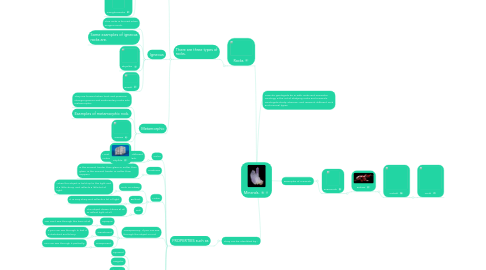
1. They can be identified by...
1.1. PROPERTIES such as
1.1.1. Color
1.1.1.1. Most minerals come in different colors from White to black.
1.1.2. Hardness
1.1.2.1. Is the mineral harder than glass or softer than glass, is the mineral harder or softer than copper?
1.1.3. Luster
1.1.3.1. Such as Glassy
1.1.3.1.1. When the object is held up to the light and it a little shiny, and reflects a little bit of light.
1.1.3.2. Brilliant.
1.1.3.2.1. It is very shiny and reflects a lot of light.
1.1.3.3. Dull
1.1.3.3.1. The object doesn't shine at all or reflect light at all.
1.1.4. Transparency- If you can see through the object or not
1.1.4.1. Opaque
1.1.4.1.1. You can't see through the item at all.
1.1.4.2. Translucent
1.1.4.2.1. If you can see through it, but it is distorted and blurry.
1.1.4.3. Transparent.
1.1.4.3.1. You can see through it perfectly.
1.1.5. Crystal Shape
1.1.5.1. Pyramid
1.1.5.2. Irregular
1.1.5.3. Rhombus
1.1.5.4. Cube
1.1.5.5. Hexagon
1.1.5.6. Rectangle
1.1.6. Reaction to acid
1.1.6.1. If the mineral fizzes or bubbles when acid is dropped on it.
1.1.7. Streak Color
1.1.7.1. This is what happens when a mineral is dragged across a piece of unweathered paper.
2. Rocks
2.1. There are three types of rocks.
2.1.1. Sedimentary
2.1.1.1. This rock is formed when sediments are pressed together.
2.1.1.2. Here are some examples of sedimentary rocks.
2.1.1.3. Siltstone
2.1.1.4. Conglomerate
2.1.2. Igneous
2.1.2.1. This rocks is formed when magma cools.
2.1.2.2. Some examples of igneous rocks are.
2.1.2.3. Rhyolite
2.1.2.4. Basalt
2.1.3. Metamorphic
2.1.3.1. They are formed when heat and pressure change igneous and sedimentary rocks into metamorphic.
2.1.3.2. Examples of metamorphic rock.
2.1.3.3. Gneiss
2.1.3.4. Phyllite
3. How do geologists tie in with rocks and minerals? Geology is the art of studying rocks and minerals. Geologists study, observe, and research different rock and mineral types.
4. Examples of minerals.
4.1. Diamonds
4.1.1. Rubies
4.1.1.1. Cobalt
4.1.1.1.1. Gold
